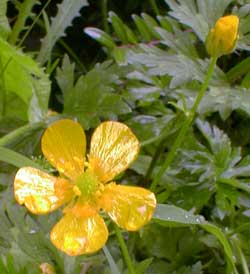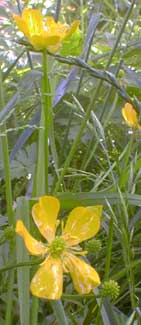
Creeping Buttercup
"One morning, very early,
before the sun was up,
I rose and found the shining dew
on every buttercup."
-Robert Louis Stevenson,
1850‚1894
1850‚1894
 Creeping Buttercup (Ranunculus repens) is one of the prettiest weeds in the Pacific Northwest. It is also troublesome on farmlands because potentially toxic to ruminants, however mildly so. It is an invasive species introduced from Europe, & can crowd out small sensitive native species in wetland areas.
Creeping Buttercup (Ranunculus repens) is one of the prettiest weeds in the Pacific Northwest. It is also troublesome on farmlands because potentially toxic to ruminants, however mildly so. It is an invasive species introduced from Europe, & can crowd out small sensitive native species in wetland areas.It has been naturalized throughout the United States for a great long while, & was originally dispersed by a combination of it having been so long grown as a garden flower, & by having tagged along in bales of hay shipped to dairymen throughout the west. It is especially common west of the Cascades all along the coast of British Columbia, Washington, & Oregon. It is less common east of the Cascades except in pockets of wetlands.
Since there's no escaping it, it's nice at least that it is very pretty. When not near pastures posing a threat to cattle, or in wetlands competing with native species, it is not so troublesome, & does not spread so aggressively as to be a burden to tended gardens.
We pull it like any ordinary weed & don't get upset that it so easily comes back. We have it growing in an untended corner of the alley road, but it never spreads into tended areas. It's a semi-evergreen perennial that gets a little wider each year from rooting itself at nodes along creeping vines, but rarely pokes up higher than a foot.
It will also self-seed for further dispersal, but for such a widespread plant, the seeds are not all that easily germinated. It is still sold as an ornamental, & if you lived somewhere where they weren't already present as weeds, & you wanted it in your garden, it would be far easier to grow them from well-rooted starts than to spread seeds hoping for successful wildflowers.
Some specially cultivated varieties include a variegated leaf form & several double-flowering varieties which are also occasionally spotted growing in the wild. If the species were to be planted intentionally it would be far better to select these restrained cultivars rather than the invasive wild form.
If its presence is unwanted, Creeping Buttercup is very easily killed by tilling it under, or just pulling & composting. There is no rational reason to resort to herbicides. Though we've let that one corner of the property ti belong to the buttercups, they have never spread into the surrounding area where it simply can't compete with bergenias & a violet-berried honeysuckle shrub.
Flowers are most numerous April through June, with later rebloom not unexpected. They do great in moist, fertile soil. Our untended ones grow near a drain pipe because they do not easily spread into dry places.